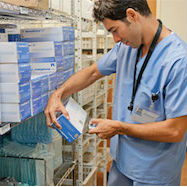Hospitals can use RFID to Track Patients, specimens, Supplies, and More.
Radiofrequency identification, or RFID, is a great solution to countless data collection challenges. In the hospital, RFID can be utilized in a variety of departments and applications to help increase accuracy and efficiency, as well as enhance patient care. Make sure your hospital is providing excellent patient care and ensuring patient safety while staying compliant with industry-leading standards.
Using RFID in the hospital can be extremely beneficial. Utilize RFID tracking technology for:
- Managing inventory
- Managing time
- Tracking patients
- Managing equipment
- Tracking supplies
RFID in the Hospital
Many processes in the hospital can be improved by using RFID technology. From admissions and administration through points-of-care to managing equipment and supplies, an RFID solution can provide your hospital with a cost-effective information system to support best practices in patient services.
Positive Patient Identification
Positive patient identification is easy with RFID technology. RFID technology does not require a line of sight to scan and collect data. By using an RFID-enabled wristband to track and identify patients, nurses will not need to adjust or disturb a sleeping patient to identify them.
Misidentification of patients can lead to medical errors. It can lead to delayed care and wasted clinical time, which can harm the patient. RFID-tagged wristbands or pediatric ankle bands allow fast and easy identification when providing medication and treatment.
RMS Omega’s exclusive RestEasy RFID solution allows nurses to positively identify infants in the NICU without having to un-swaddle or wake them. By using a comfortable and adjustable RFID infant ankle band on each infant, the RFID reader will read through blankets and incubators with ease, all while letting the baby rest.
Inventory Management 
Using RFID tags in combination with fixed portals or handheld readers is a great way to track both fixed assets and consumable inventory or supplies. Fixed assets include equipment ranging from wheelchairs and cleaning machines to crash carts and multi-million-dollar imaging machines. It’s important to protect your assets, track their location throughout the hospital, identify staff using the equipment and monitor any scheduled maintenance.
Consumable inventory may consist of medical supplies or materials, including bandages, gauze, blood bags, medications, linens, disposable syringes, or even office supplies. It is necessary to track these supplies for a few reasons:
- Know when certain supplies need to be reordered.
- Ensure each room or cart has the needed items for each patient and each shift.
- Track the medical supplies used for each patient to ensure accurate patient charging.
Accurate Patient Charging
Ensure all the medical supplies used for each patient and each room are accurately accounted for. Use fixed RFID portals in each patient room to quickly and accurately scan each item used for their care without impacting the nurses’ workflow. Medical supplies and inventory are simply tagged with a UHF RFID tag. As the nurse enters the room, they scan each item at the RFID portal. The supplies scanned and used are then tied to that patient’s record. When discharged, patients are accurately billed for all the supplies and medications used during their stay.
RFID technology eliminates the need for nurses to manually enter this data into a computer, giving them more time to focus on each patient’s care.
Additional Uses for RFID in the Hospital
In addition to positive patient identification, inventory management, and accurate patient charging, RFID has many other uses in the hospital. Additional uses for RFID include:
- Specimen tracking & labeling
- Medical device tracking
- Document & data file tracking
- Medication verification
- Surgical instrument tracking
